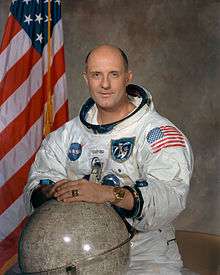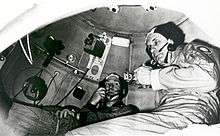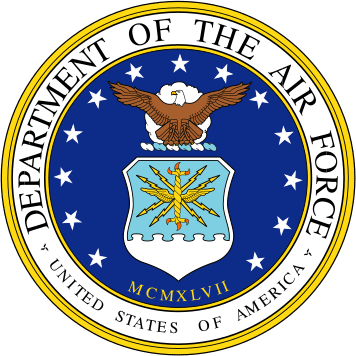Thomas P. Stafford
| Thomas P. Stafford | |
|---|---|
 | |
| NASA Astronaut | |
| Nationality | American |
| Status | Retired |
| Born |
September 17, 1930 Weatherford, Oklahoma, U.S. |
Other names | Thomas Patten Stafford |
Other occupation | Test pilot, consultant |
| USNA, B.S. 1952 | |
| Rank | Lieutenant General, USAF |
Time in space | 21d 03h 42m |
| Selection | 1962 NASA Group 2 |
| Missions | Gemini 6A, Gemini 9A, Apollo 10, ASTP |
Mission insignia |
|
| Retirement | November 1, 1975 |
| Awards |
|
Thomas Patten "Tom" Stafford (born September 17, 1930), (Lt Gen, USAF, Ret.), is an American former Air Force officer, test pilot, and NASA astronaut. He flew aboard two Gemini space flights; and in 1969 was the Commander of Apollo 10, the second manned mission to orbit the Moon and the first to fly a Lunar Module there.
In 1975, Stafford was Commander of the Apollo-Soyuz Test Project flight, the first joint U.S.-Soviet space mission. A Brigadier General at the time, he became the first general officer to fly in space. He was the first member of his Naval Academy class to pin on the first, second and third stars of a general officer.
He made six rendezvous in space and logged 507 hours of space flight. He has flown over 120 different types of fixed wing and rotary aircraft and four different types of spacecraft.
Biography
Early years and education
Stafford was born September 17, 1930, in Weatherford, Oklahoma, where he graduated from Weatherford High School in 1948. He was a Boy Scout and he earned the rank of Star Scout.[1]
Stafford earned a Bachelor of Science degree with honors in 1952 from the United States Naval Academy, Annapolis, Maryland, and was commissioned a Second Lieutenant in the United States Air Force. He received his pilot wings at Connally AFB, Waco, Texas, in September 1953. He completed advanced interceptor training and was assigned to the 54th Fighter-Interceptor Squadron, Ellsworth AFB, Rapid City, South Dakota. In December 1955 he was assigned to the 496th Fighter Interceptor Squadron, Hahn Air Base, West Germany, where he performed the duties of pilot, flight leader, and flight test maintenance officer, flying F-86Ds. He attended the USAF Experimental Test Pilot School and received the A. B. Honts Award as the outstanding graduate in 1959.
He was an instructor in flight test training and specialized academic subjects-establishing basic textbooks and directing the writing of flight test manuals for use by the staff and students. He is co-author of the Pilot's Handbook for Performance Flight Testing and the Aerodynamics Handbook for Performance Flight Testing.
NASA career
Stafford was selected among the second group of NASA astronauts in September 1962 by the National Aeronautics and Space Administration (NASA) to participate in Projects Gemini and Apollo.
Project Gemini

Stafford was originally scheduled to fly with veteran astronaut Alan Shepard on the first manned Gemini mission, Gemini 3. But when Shepard was removed from the flight rotation due to an inner ear problem, Stafford was reassigned to backup pilot for that mission.[2] In December 1965, he, along with spacecraft commander Wally Schirra, piloted Gemini VI during the first rendezvous in space, and helped develop techniques to prove the basic theory and practicality of a space rendezvous.
In June 1966 he commanded Gemini IX with Eugene Cernan due to the deaths of prime crew members Charlie Bassett and Elliot See. He performed a demonstration of an early rendezvous that would be used in Apollo 10: the first optical rendezvous; and a lunar orbit abort rendezvous. Until the launch of STS-94 in 1997, he held the record for the briefest duration between spaceflights, at 5 months 19 days.
Apollo program
From August 1966 to October 1968, Stafford headed the mission planning analysis and software development responsibilities for the astronaut group for Apollo program.
Stafford was the lead member of the group which helped formulate the sequence of missions leading to the first lunar landing mission. He demonstrated and implemented the theory of a pilot manually flying the Saturn booster into orbit and the translunar injection maneuver.
Stafford also was largely responsible for NASA adopting color television for its spaceflights.[3] Apollo 10 originally planned to use the black-and-white Apollo TV camera, but Stafford was determined to let the American public share in the beauty of the missions they were funding.[3] The development of a sequential color television system by Westinghouse caught his attention and in the early days of 1969, the demonstration made for him was the catalyst for his pushing NASA to adopt the color format.[3] Once NASA saw how much publicity the color TV pictures generated, the format became standard on all subsequent missions (bar Apollo 11's lunar surface TV camera - which was not flight-approved for color).[3]
Stafford was Commander of Apollo 10 in May 1969, which included the first flight of the Lunar Module during a Moon orbit, the first rendezvous while in the Moon environment, and the entire lunar landing mission except for the actual landing. He also did reconnaissance and evaluation of future landing sites for Apollo 11.
Stafford and his crewmates, John Young and Gene Cernan, were cited in the Guinness Book of World Records for the highest speed ever attained by man— during Apollo 10's return from the Moon, the spacecraft reached 24,791 statute miles per hour (39,897 kilometres per hour).
He was assigned as head of the NASA Astronaut Corps in June 1969, responsible for the selection of flight crews for projects Apollo and Skylab. He reviewed and monitored flight crew training status reports, and was responsible for coordination, scheduling, and control of all activities involving NASA astronauts.
In June 1971, Stafford was assigned as Deputy Director of Flight Crew Operations at the NASA Manned Spacecraft Center. He was responsible for assisting the director in planning and implementation of programs for the astronaut group, the Aircraft Operations, Flight Crew Integration, Flight Crew Procedures, and Crew Simulation and Training Divisions. Also in 1971, Stafford served as a pallbearer for the crew of the ill-fated Soyuz 11.
Apollo-Soyuz Test Project

Stafford logged his fourth space flight as Apollo commander of the Apollo-Soyuz Test Project (ASTP) mission, July 15–24, 1975—a joint space flight culminating in the historic first meeting in space between American astronauts and Soviet cosmonauts.
After announcement of the crew members, they immediately began an intensive two-year training program, which included learning the Russian language and making frequent trips to the USSR, where they trained for weeks at Star City, the cosmonaut training center near Moscow.
He earned the Air Force Command Pilot Astronaut Wings.
Post-NASA career
Stafford assumed command of the Air Force Flight Test Center November 4, 1975. He was promoted to the rank of Major General August 9, 1975, with date of rank of June 1, 1973. (Into the 1990s, Edwards AFB had a railcar diner named "Stafford Station" in tribute to him, which could also be taken as a play on the actual train station.)
Promoted to rank of Lieutenant General on March 15, 1978, he assumed duties as Deputy Chief of Staff, Research Development and Acquisition, Headquarters USAF, Washington, DC, on May 1, 1978. He retired from the Air Force in November 1979.
In June 1990, Vice President Quayle and Admiral Richard Truly, then the NASA administrator, asked Stafford to chair a committee to independently advise NASA how to carry out President George H. W. Bush's vision of returning to the Moon, this time to stay, and then go on to explore Mars. Stafford assembled teams of 40 full-time and 150 part-time members from the DOD, DOE and NASA, and completed the study called America at the Threshold, a road map for the next 30 years of U.S. manned spaceflight. Stafford and Quayle held a news conference at the White House in June 1991 to announce the recommendations to the public.
He co-founded the technical consulting firm of Stafford, Burke, and Hecker, Inc. in Alexandria, Virginia. He sits on the Board of Directors of six corporations listed on the New York Stock Exchange, one listed on the American Exchange, and two others, including Seagate Technology, Inc., the largest independent hard disk drive maker in the world. He has served as an advisor to a number of governmental agencies including NASA and the Air Force Systems Command. He was a defense advisor to Ronald Reagan during the 1980 presidential campaign and a member of the Reagan transition team. He has also served as spokesman for Omega watches.
He served on the National Research Council's Aeronautics and Space Engineering Board; the Committee on NASA Scientific and Technological Program Reviews, and Vice President Quayle's Space Policy Advisory Council. He was Chairman of the NASA Advisory Council Task Force on Shuttle-Mir Rendezvous and Docking Missions, and is currently the Chairman of the NASA International Space Station Advisory Committee. He is an honorary board member of the humanitarian organization, Wings of Hope.[4]
Stafford wrote the epilogue of the book Falling to Earth: An Apollo 15 Astronaut's Journey to the Moon by fellow Apollo astronaut Al Worden.[5] In 2004, working with author Michael Cassutt, they published a book titled We Have Capture: Tom Stafford and the Space Race.[6]
Personal life
Stafford's first wife was the former Faye L. Shoemaker. They had two daughters, Dionne Kay, and Karin Elaine. They also have two grandsons, Thomas P. Stafford II and Andrew Alexi Harrison. He later married the former Linda Ann Dishman of Chelsea, Oklahoma. They have two sons, Michael Thomas, and Stanislav "Stas" Patten. Linda has two children from a previous marriage, Kassie Pierce (Hill) and Mark Hill, and four grandchildren: Sloane, Lee, Marcus, and Tara.
Stafford enjoys hunting, weight lifting, soaring, scuba diving, fishing, and swimming.[7]
Organizations
Stafford is a fellow of the American Astronautical Society, American Institute of Aeronautics and Astronautics, the Society of Experimental Test Pilots, and a member of the Explorers Club.
Awards and honors
| “ | This is the greatest honor of my life. I am very proud to have contributed to our nation's future in space and I am deeply grateful for the opportunity to have participated in the beginning of America's venture into the new and endless frontier. | ” |
| — Upon receiving the Congressional Space Medal of Honor.[8] | ||
In 2008 he received the Elmer A. Sperry Award, jointly with Glynn S. Lunney, Aleksei A. Leonov and Konstantin D. Bushuyev, for their work on the Apollo-Soyuz mission and the Apollo-Soyuz docking interface design.[9]
In 2011, Stafford was awarded the National Aeronautic Association Wright Brothers Memorial Trophy, the most prestigious honor in aviation, which is presented annually to a living American for "significant public service of enduring value to aviation in the United States." He also received the Air Force Association's Lifetime Achievement Award on September 21, 2011. He was elected to the National Academy of Engineering in 2014.

Stafford's many military decorations and awards include the Air Force Distinguished Service Medal with two oak leaf clusters, Distinguished Flying Cross with oak leaf cluster, Air Force Commendation Medal and Air Force Outstanding Unit Award ribbon with three oak leaf clusters.
Other awards presented to Stafford include the Presidential Medal of Freedom, NASA Distinguished Service Medal with oak leaf cluster, NASA Exceptional Service Medal with oak leaf cluster, the American Institute of Aeronautics and Astronautics Octave Chanute Award (1976), the Veterans of Foreign Wars National Space Award, the Golden Plate Award for Science and Exploration (1976), National Geographic Society's General Thomas D. White USAF Space Trophy (1975), the A. B. Honts Award as the outstanding graduate from the USAF Experimental Test Pilot School, and the Fédération Aéronautique Internationale Gold Space Medal. In 1966, he was co-recipient of the AIAA Award, and in 1969 he received the National Academy of Television Arts and Sciences Special Trustees Award.[10] On 12 April 2011, Stafford received the Russian Medal "For Merit in Space Exploration" "for outstanding contribution to the development of international cooperation in manned space flight".
Stafford received the Harmon International Aviation Trophy twice—in 1966 for piloting Gemini 6A, and in 1976 trophy was presented jointly to Stafford and cosmonaut Alexei Leonov for their work on ASTP.
Stafford is an inductee of the U.S. Astronaut Hall of Fame and the International Space Hall of Fame.[11][12]
In 1979, Stafford was awarded the Society of Experimental Test Pilots James H. Doolittle Award. On January 19, 1993, he received the Congressional Space Medal of Honor.
He is the recipient of several honorary degrees. These include a Doctorate of Science from Oklahoma City University; a Doctorate of Laws, Western State University; a Doctorate of Communications, Emerson College, Boston, Massachusetts; and a Doctorate of Aeronautical Engineering, Embry-Riddle Aeronautical University, Daytona Beach, Florida.
Legacy
Stafford is heavily honored in his hometown of Weatherford, also in Weatherford, there is a building on the Southwestern Oklahoma State University named in his honor, including his name being on the local airport, Thomas P. Stafford Airport, and The Stafford Air & Space Museum.[13]
A building, home to the FAA Academy, at the Mike Monroney Aeronautical Center in Oklahoma City, OK is also named in his honor.
In media
Stafford played himself in the 1974 TV movie Houston, We've Got a Problem. In the 1996 TV movie Apollo 11 he was played by Tony Carlin. In the 1998 HBO miniseries From the Earth to the Moon he was played by Steve Hofvendahl. Stafford was briefly portrayed by an extra in the pilot episode of the FX show The Americans.
British rock band New Model Army has quoted Stafford in the lyrics to their song "Space" included on their fifth studio album Impurity in 1990.
Physical description
- Weight: 175 lb (79 kg)
- Height: 6 ft 0 in (1.83 m)
- Hair: Black
- Eyes: Blue[14]
See also
References
- ↑ Thomas P. Stafford at scouting.org
- ↑ On the Shoulders of Giants
- 1 2 3 4 Lebar, Stanley (Summer 1997). "The Color War goes to the Moon" (PDF). Invention and Technology. Retrieved 2013-10-18.
- ↑ Wings-of-hope.org
- ↑ Falling to Earth web site
- ↑ We Have Capture: Tom Stafford and the Space Race (Amazon.com)
- ↑ "Biographical Data". NASA JSC. Retrieved June 24, 2016.
- ↑ Thomas P. Stafford's quotation
- ↑ "The Elmer A. Sperry Award". Elmer A. Sperry Board of Award. Retrieved 14 November 2015.
- ↑ United States Air Force bio:Thomas P. Stafford
- ↑ Thomas P. Stafford inducted into the U.S. Astronaut Hall of Fame
- ↑ Thomas P. Stafford inducted into the International Space Hall of Fame
- ↑ AirNav: KOJA - Thomas P Stafford Airport
- ↑ Thomas Stafford's physical description
External links
| Wikimedia Commons has media related to Thomas Stafford. |
- Stafford's official NASA biography
- Lieutenant General Thomas P. Stafford United States Air Force biography
- Appearances on C-SPAN

